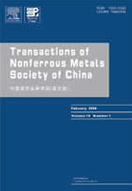Correspondence between low-energy twin boundary density and thermal-plastic deformation parameters in nickel-based superalloy
(1. College of Materials Science and Engineering, Chongqing University, Chongqing 400044, China;
2. State Key Laboratory of Materials Processing and Die & Mould Technology, Huazhong University of Science and Technology, Wuhan 430074, China;
3. School of Civil Engineering, Chongqing University, Chongqing 400045, China)
2. State Key Laboratory of Materials Processing and Die & Mould Technology, Huazhong University of Science and Technology, Wuhan 430074, China;
3. School of Civil Engineering, Chongqing University, Chongqing 400045, China)
Abstract: To deeply understand and even describe the evolutions of the low-energy twin boundary density (BLD∑3n) in a thermal-plastic deformation process, an improved twin density model as a function of average grain size and stored energy is developed. For Nimonic 80A superalloy, the model is solved based on the EBSD statistical results of grain size and BLD∑3n in the specimens compressed at temperatures of 1273-1423 K and strain rates of 0.001-10 s-1. The corresponding relationships of BLD∑3n with stored energy and grain size varying with temperature and strain rate are clarified by the superimposed contour plot maps. It is summarized that BLD∑3n increases with increasing stored energy and decreasing grain size, and higher BLD∑3n with finer grains corresponds with lower temperatures and higher strain rates. Such relationships are described by the improved twin density model, and the prediction tolerance of the solved model is limited in 2.8%.
Key words: Nimonic 80A superalloy; twin boundary; microstructure evolution; dynamic recrystallization; grain size; stored energy

